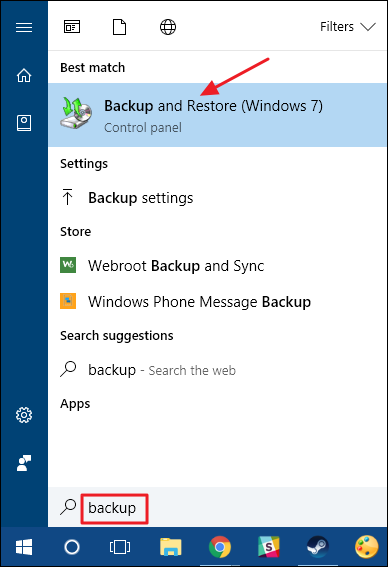Step One: Open System Image Backup
The process of finding the System Image Backup tool is different in Windows 7 than in Windows 8 and 10, so we’ll show you to find the tool in all versions, and then explain how to create and use the system image.
Open System Image Backup in Windows 10
In Windows 10, hit Start, type “backup,” and then select the entry.

In the “Backup and Restore (Windows 7)” window, click the “Create a system image” link.

Open System Image Backup in Windows 8
In Windows 8, hit Start, type “file history,” and then select the “File History” entry.

In the “File History” window, click the “System Image Backup” link.

Open System Image Backup in Windows 7
Hit Start, click the arrow to the right of the “Getting Started” item, and then click “Back up your files.”

In the “Backup and Restore” window, click the “Create a system image” link.

Step Two: Create a System Image Backup
Once you’ve opened the system image tool, the steps for creating a system image are the same in Windows 7, 8, or 10.
When you first open the tool, it will scan your system for external drives. You can then decide where you want to save the image. It can be to an external drive, multiple DVD’s, or on a network location. Select where you want to save your backup and then click “Next.”

By default, the tool only backs up your system drive. You can include other drives if you want, but remember that this will add to the size of the final image. Typically, we like to create separate image backups for each drive.

At the confirmation screen, notice the amount of space the image may take. If anything doesn’t look right, you can still go back and make adjustments. If everything looks okay, click the “Start Backup” button.

You’ll see a progress meter as the tool creates the image.

It can take a while. In this example, we’re backing up a drive with about 319 GB of data. It took about 2.5 hours when backed up to an external hard disk connected to our PC via USB. Your time will vary depending on your PC and the type of storage to which you’re backing up.
Step Three: Create a System Repair Disc
When the backup is complete, Windows gives you the option to create a system repair disc. You can use this disc to start your PC and restore from your image backup in the event you ever need to replace your hard drive and can’t start Windows. We highly recommend you go ahead and create the disc, then label and store it in a secure location.

Select the drive you want to use to create the disc and then click the “Create Disc” button.

When it comes time to restore the image, you can start your PC from the recovery disc to get access to a number of recovery tools—including “System Image Recovery.”
